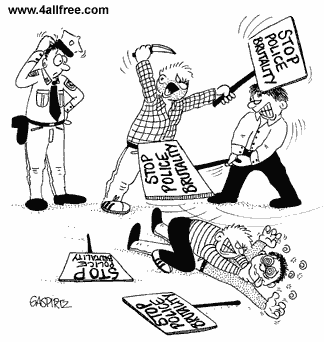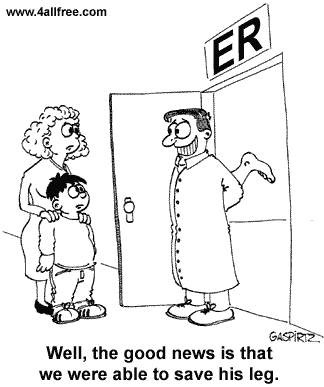Jokes often depend on the humor of the unexpected, the mildly taboo (which can include the distasteful or socially improper), or playing off stereotypes and other cultural beliefs. Many jokes fit into more than one category.
Subjects
Political jokes are usually a form of satire. They generally concern politicians and heads of state, but may also cover the absurdities of a country's political situation. Two large categories of this type of jokes exist. The first one makes fun of a negative attitude to political opponents or to politicians in general. The second one makes fun of political clichés, mottos, catch phrases or simply blunders of politicians. Some, especially the you have two cows genre, derive humor from comparing different political systems.


Professional humor includes caricatured portrayals of certain professions such as lawyers, and in-jokes told by professionals to each other.

Mathematical jokes are a form of in-joke, generally designed to be understandable only by insiders.
Ethnic jokes exploit ethnic stereotypes. They are often racist and frequently considered offensive.
For example, the British tell jokes starting "An Englishman, an Irishman and a Scotsman..." which exploit the supposed parsimony of the Scot, stupidity of the Irish, or some combination. Such jokes exist among numerous peoples.
Additionally, many cultures have Black jokes, which exploit the supposed stupidity and/or supposed incompetence of people of African descent.
Racially offensive humor is increasingly unacceptable, but there are similar jokes based on other stereotypes such as blonde jokes.
Religious jokes fall into several categories:
* Jokes based on stereotypes associated with people of religion (e.g. nun jokes, priest jokes, or rabbi jokes)
* Jokes on classical religious subjects: crucifixion, Adam and Eve, St. Peter at The Gates, etc.
* Jokes that collide different religious denominations: "A rabbi, a medicine man, and a pastor went fishing..."
Self-deprecating or self-effacing humor is superficially similar to racial and stereotype jokes, but involves the targets laughing at themselves. It is said to maintain a sense of perspective and to be powerful in defusing confrontations. Probably the best-known and most common example is Jewish humor. The egalitarian tradition was strong among the Jewish communities of Eastern Europe in which the powerful were often mocked subtly. Prominent members of the community were kidded during social gatherings, part a good-natured tradition of humor as a leveling device. A similar situation exists in the Scandinavian "Ole and Lena" joke.
Self-deprecating humor has also been used by politicians, who recognize its ability to acknowledge controversial issues and steal the punch of criticism - for example, when Abraham Lincoln was accused of being two-faced he replied, "If I had two faces, do you think this is the one I’d be wearing?".
Dirty jokes are based on taboo, often sexual, content or vocabulary. Many dirty jokes are also sexist.
Other taboos are challenged by sick jokes and gallows humor; to joke about disability is considered in this group.
Surrealist or minimalist jokes exploit semantic inconsistency, for example: Q: What's red and invisible? A: No tomatoes..
Anti Jokes are jokes that aren't funny in regular sense, and often can be decidedly unfunny, but rely on absurdity, surrealism and abstractness of the joke or situation to provide entertainment.
An elephant joke is a joke, almost always a riddle or conundrum and often a sequence of connected riddles, that involves an elephant.
Comedian often point out that a joke is always made at the expense of somebody and are rarely meant to be racial or sexist instigators. Their intention rather to be entertaining rather than offensive to sensitive groups.

Styles
The question / answer joke, sometimes posed as a common riddle, has a supposedly straight question and an answer which is twisted for humorous effect; puns are often employed. Of this type are knock-knock joke, lightbulb joke, the many variations on "why did the chicken cross the road?", and the class of "What's the difference between..." joke, where the punch line is often a pun or a spoonerism linking two apparently entirely unconnected concepts.
Some jokes require a double act, where one respondent (usually the straight man) can be relied on to give the correct response to the person telling the joke. This is more common in performance than informal joke-telling.
A shaggy dog story is an extremely long and involved joke with a weak or completely nonexistent punchline. The humor lies in building up the audience's anticipation and then letting them down completely. The longer the story can continue without the audience realising it is a joke, and not a serious anecdote, the more successful it is. Shaggy jokes appear to date from the 1930s, although there are several competing variants for the "original" shaggy dog story. According to one, an advertisement is placed in a newspaper, searching for the shaggiest dog in the world. The teller of the joke then relates the story of the search for the shaggiest dog in extreme and exaggerated detail (flying around the world, climbing mountains, fending off sabre-toothed tigers, etc); a good teller will be able to stretch the story out to over half an hour. When the winning dog is finally presented, the advertiser takes a look at the dog and states: "I don't think he's so shaggy"



















0 comments:
Post a Comment